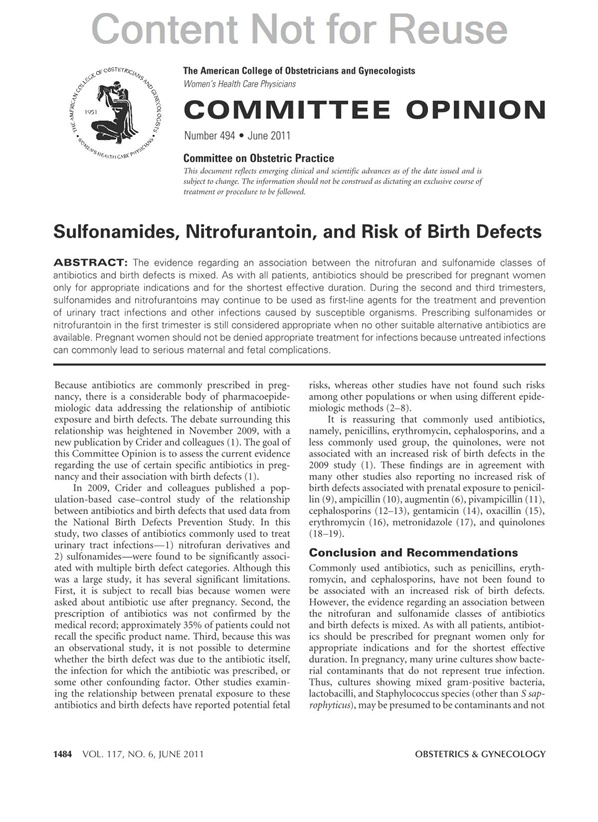
During the second and third trimester of pregnancy, sulfonamides and nitrofurantoins may be used as first-line agents for urinary tract and other infections, but in the first trimester, these agents may be used when no alternatives are available, according to a Committee Opinion from the American College of Obstetricians and Gynecologists (ACOG).
The opinion is published in the June issue of Obstetrics & Gynecology. According to the study authors, a 2009 case-control study of data from the National Birth Defects Prevention Study found that nitrofurans and sulfonamides were significantly associated with multiple birth defects, whereas penicillins, erythromycin, cephalosporins, and the quinolones were not.
However, the authors acknowledge several limitations of the 2009 study. In addition, they note that "other studies have not found such risks among other populations or when using different epidemiologic methods."
According to the authors, antibiotics "should be prescribed for pregnant women only for appropriate indications and for the shortest effective duration."
They add that many urine cultures show bacterial contaminants that do not represent true infection. However, when selecting an antibiotic for a true infection during the first trimester, "health care providers should consider and discuss with patients the benefits as well as the potential unknown risks of teratogenesis and maternal adverse reactions."
They suggest that prescribing sulfonamides or nitrofurantoins in the first trimester is still considered appropriate when no other suitable alternative antibiotics are available.
"During the second and third trimesters, sulfonamides and nitrofurantoins may continue to be used as first-line agents for the treatment and prevention of urinary tract infections and other infections caused by susceptible organisms," they write.
They also caution that "pregnant women should not be denied appropriate treatment for infections because untreated infections can commonly lead to serious maternal and fetal complications."
Obstet Gynecol. June 2011 - Volume 117 - Issue 6 - ppg 1484-1485
Related Link
The National Women’s Health Information Center, a service of the US Department of Health and Human Service’s Office on Women’s Health, provides a comprehensive Web site, useful for patient education, on the subject of Pregnancy and Medicines.
Clinical Context
Antibiotics are often prescribed in pregnancy, resulting in considerable pharmacoepidemiologic evidence regarding the association of prenatal antibiotic exposure and birth defects. Teratogenesis caused by drugs or other agents is most likely to occur during the first trimester, when organs and nervous systems are forming. A National Birth Defects Prevention Study report published in 2009 suggested that nitrofurans and sulfonamides, which are 2 antibiotic classes often prescribed for urinary tract infections, may increase the risk for birth defects when taken during the first trimester.
Therefore, ACOG reviewed available evidence on maternal use of nitrofurans, sulfonamides, and other specific antibiotics during pregnancy and subsequent development of birth defects in the offspring. ACOG noted several methodologic limitations in research linking nitrofuran and sulfonamide use to birth defects, and it also found data supporting the safety of various other antibiotics used appropriately in pregnant women. The goals of this ACOG Committee Opinion were to summarize the current evidence linking prenatal antibiotic exposure with birth defects and to issue evidence-based recommendations for use of antibiotics during pregnancy.
Study Highlights
- This ACOG Committee Opinion summarized current evidence linking prenatal antibiotic exposure with birth defects and offered evidence-based guidelines for antibiotic use during pregnancy.
- A population-based case-control study, published in 2009, of the association between antibiotics and birth defects used data from the National Birth Defects Prevention Study.
- This study showed that nitrofuran derivatives and sulfonamides were significantly associated with multiple categories of birth defects.
- Limitations of this study include recall bias, lack of confirmation of antibiotic prescription by the medical record, inability of roughly one third of patients to recall the specific product name, and observational design with confounding.
- Some other studies of the association between prenatal exposure to these antibiotics and birth defects showed potential fetal risks, whereas still other studies did not show these risks in other populations or when using different epidemiologic methods.
- In the 2009 study, penicillins, erythromycin, cephalosporins, and quinolones were not associated with an increased risk for birth defects.
- Many other studies corroborate these findings, with no increased risk for birth defects associated with prenatal exposure to penicillin, ampicillin, amoxicillin/clavulanate, pivampicillin, cephalosporins, gentamicin, oxacillin, erythromycin, metronidazole, and quinolones.
- For pregnant women, as for all patients, antibiotics should be prescribed only for appropriate indications and for the shortest effective duration.
- Bacterial contaminants of urine cultures are common in pregnancy and do not reflect the actual infection.
- Organisms in urine cultures that may be presumed to be contaminants and therefore not treated are mixed gram-positive bacteria, lactobacilli, and Staphylococcus species other than S saprophyticus.
- For true infections occurring in the first trimester of pregnancy, clinicians should consider the benefits and potential unknown risks for teratogenesis and maternal adverse reactions, and they should discuss these with patients.
- In the first trimester, prescribing sulfonamides or nitrofurantoins is still considered appropriate when there are no other suitable alternative antibiotics.
- Sulfonamides and nitrofurantoins may continue to be used during the second and third trimesters as first-line agents to treat and prevent urinary tract and other infections caused by susceptible organisms.
- Untreated infections may cause serious maternal and fetal complications, and pregnant women therefore should not be denied appropriate treatment.
Clinical Implications
- The evidence linking prenatal exposure to nitrofurans and sulfonamides with birth defects is mixed. Penicillins, erythromycin, cephalosporins, and other commonly used antibiotics have not been found to be associated with an increased risk for birth defects.
- During the second and third trimesters, sulfonamides and nitrofurantoins may continue to be used as first-line agents to treat and prevent urinary tract and other infections caused by susceptible organisms. Even in the first trimester, prescribing sulfonamides or nitrofurantoins is still considered appropriate when no other suitable alternative antibiotics are available.





 留言列表
留言列表
 線上藥物查詢
線上藥物查詢 